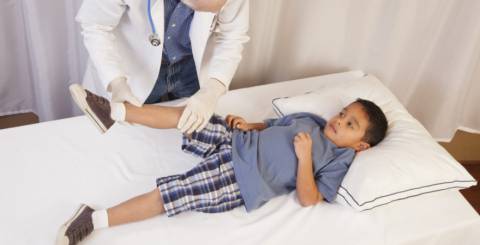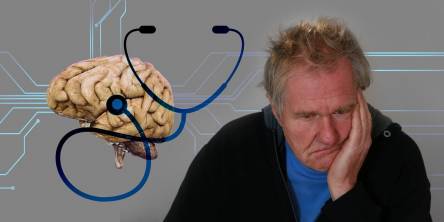Toxic Synovitis, Causes, and Symptoms

Toxic synovitis is a condition that commonly occurs in children and presents itself with hip pain, which is usually only temporary. It is more common in boys and in general affects mostly children in the age of three to eight. As mentioned, it is in most cases temporary and goes away by itself in one to two weeks.
What are the symptoms of toxic synovitis?
The most present symptom of toxic synovitis is a pain in the hip area. It may occur in only one or both hips. The pain is strongest when changing positions, such as standing up after sitting or lying down, for a long period of time. Other symptoms are also a change in the way the child walks, such as limping or walking on tiptoe, a reaction to the pain. Sometimes hip pain isn't present at all but presents itself in the knee area or pain in the thigh. In some cases, a low fever is present. In younger children, refusing to walk or crying and being irritated are indicators that something might not be right.
What causes toxic synovitis?
It is still unknown what exactly causes toxic synovitis, however, it almost always occurs in children who have an infection, due to bacteria, fungus or a virus. This is why it is believed that a possible cause of toxic synovitis may be due to the substances that the body´s immune system produces to fight these infections.
How is toxic synovitis diagnosed?
Getting a diagnosis of toxic synovitis usually requires a long series of different kinds of tests and exams. The symptoms of toxic synovitis are similar to those of more serious conditions, which is why physicians try to rule out these serious conditions first. Some of these conditions are:
- Lyme disease, an infection caused by the bacteria Borrelia burgdorferi sensu lato. This bacterial infection is passed through a bite from an infected black-legged or deer tick. The infection starts to show its first symptoms 24 or even 48 hours after the bite, which is why most people don't remember having been bitten by a tick. Other than the pain, this infection also presents itself with a rash on the skin. This rash is around the area where the bite was and it takes up to four weeks for this rash to disappear. Fear is another common symptom that both Lyme disease and toxic synovitis share, as well as fatigue and muscle aches. Lyme disease has the most positive outcome when it's treated early. If left untreated it may lead to numbness in the arms or legs, brain disorders, short-term memory loss, and heart rhythm disorders.
- Legg-Calve-Perthes disease, a hip disorder in children, caused by a blockage in the blood flow to the head of the femur. If this blood flow is stopped for a longer period of time, the bone will die and stop growing. This condition is very rare, but very serious and requires immediate attention. There are surgical and non-surgical treatment options, and when treated early, the outcome is very positive and most children grow into adulthood with no complications at all.
- Septic arthritis, also an infection, presents itself by hip pain as one of its most common symptoms. It is usually caused by bacteria, but may in some cases also be caused by a virus or fungus. This usually affects the knee or the hip, resulting in an inflammation of the joints in this area. In rare cases, not only one but various areas and joints may be affected. This condition requires immediate attention as well, to prevent the infection from spreading and affecting larger areas of the body.
To be able to rule out these conditions and diagnose toxic synovitis, the first step to take will be a physical exam. This will help the doctor locate which part of the body hurts during and after certain movements. The hip pain might require an ultrasound of the hip, to examine the fluid in the joint. If an inflammation is present, this may be visible during an ultrasound. Blood tests are used to show the gravity of the infection. This helps detect the cause of the infection as well. X-Rays are used to rule out Legg-Calve-Perthes, which is visible correctly only through an X-Ray.
How is toxic synovitis treated?
The treatment of toxic synovitis focuses on easing the discomfort and treating the symptoms. The condition itself usually goes away after a few weeks. Medications are used against the pain, mostly over-the-counter painkillers such as ibuprofen, which works against the pain, as well as the inflammation. Should these over-the-counter pills not work, the doctor may prescribe stronger pain-killers. These should only be taken after advising a doctor and one should never give children stronger pain medication unless the doctor advised you to do so.
Children that are suffering due to toxic synovitis need to rest, as it speeds up the healing process. Walking shouldn't present a problem, however, any further activities such as running or other sports should be completely avoided during treatment. Children should also not place any weight at all on the hip, for example by carrying heavier objects.
There are no complications of the toxic synovitis itself, however, in some cases, children who are being treated against this condition may experience severe pain or pain in the hip or thigh that lasts for more than three weeks. If the pain isn't going away and the fever persists even after taking anti-inflammatory medications, you should visit a doctor to check for a different treatment and do further tests to make sure that no other cause is responsible for the present symptoms.
Although it usually goes away after up to three weeks, some children require a longer treatment of up to five weeks. Although the condition completely clears out after this time period, it is a condition that keeps reoccurring when the child gets an infection, even a cold.
Similar Articles
Most people are familiar with sciatica, defined as low back pain that spreads downward into the left or right buttock, leg, and, in some cases, foot. The pain can be intense in some situations, and despite popular belief, sciatica typically resolves within three months with conservative treatment.
Have you recently heard about the incredible benefits of stem cell therapy for Alzheimer's and want to try this therapy for your loved one? Before doing so, it's important to know that while stem cell therapy is effective, post-treatment care plays a key role in recovery, too.
Discover 5 effective at-home remedies to combat winter diseases. From flu to colds, learn how to stay healthy and resilient during the chilly season.
Clickbait articles. Wild conspiracies. Misheard conversations. All of these things can lead to misinformation. Misinformation can become incredibly dangerous. Not only does it cause fear, but it can influence decision-making. People have allowed lies to influence their healthcare and voting habits. Not only this, but it can create prejudices that can ruin lives.
Conditions like Parkinson's, essential tremor, and dystonia are on the rise, affecting people of all ages and backgrounds. From subtle tremors to major coordination issues, these disorders can greatly affect daily life. Understanding their causes, symptoms, and treatments helps us detect and manage them early, improving overall quality of life.
When it comes to personal hygiene, ears aren’t usually something people tend to worry about. You may give them a quick rinse while in the shower, and then not think twice about it, that is until they start bothering you. Ears are generally thought of as self-cleaning, as earwax tends to soften on its own and not build up.
Hardly anyone is ever prepared for death, even if it’s not unexpected. Unfortunately, most of the leading causes of death in Illinois and all over the United States are unexpected. On the other hand, most are also preventable. Here’s a look at the top five leading causes of death in Illinois.
Cancer is diagnosed every two minutes in the UK, a word that instills dread and evokes fear and worry. Treating cancer can often be a rollercoaster.
It's a good idea to discuss Crohn's disease with your doctor if you experience pain. Crohn's disease frequently causes pain, but there are ways to manage it.









